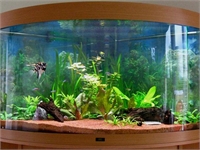
Replacing Aquarium Water Quickly
Important Notice: Our web hosting provider recently started charging us for additional visits, which was unexpected. In response, we're seeking donations. Depending on the situation, we may explore different monetization options for our Community and Expert Contributors. It's crucial to provide more returns for their expertise and offer more Expert Validated Answers or AI Validated Answers. Learn more about our hosting issue here.

Replacing Aquarium Water Quickly
You must be logged in to post a comment.
Aquariums are entertaining… right? Sure they are, in a low-key sort of way. Studies (that cost millions of taxpayer dollars, no doubt) have shown that watching fish swim around in an aquarium can lower your stress level and even your blood pressure. Of course, if you already have low blood pressure this could knock you into a coma, but how many Americans have low blood pressure?
However, if you want the benefits of an aquarium, you have to own an aquarium, and preferably keep it somewhere where you can see it most of the time. And if you own an aquarium, you will have to do regular maintenance on your tank, as the experts say you should. This means siphoning out from 10-30 percent of the water (some suggest exchanging as much as 50%) every week and replacing it with an equal or greater amount of water, depending on how much water has evaporated since your last water change.
All the experts agree that you should do this every week. If you have a standard freshwater setup with heartier varieties of fish (such as goldfish, platys, tetras, a betta—never have more than one in a tank— plecostomus and barbs), I personally believe that this is crap. I suspect that the people writing these “experts” articles are on the payroll of companies that sell aquarium filters and/or water treatment chemicals. I do water exchanges once a month—if that often—and my fish are doing fine, the water always looks clean and the tank never stinks. Yes, nitrogen from urea (that would be fish pee to the layman) does build up, but not to toxic levels as quickly as some claim.
Siphoning is a slow process, especially if you live in a small apartment and have to use empty gallon water battles for the job. It can take nearly 2 minutes to siphon the water into the jug, depending on the bore diameter of the siphon tube, then you empty the jug and do the whole process over again. If you have a medium-sized tank like mine (32 gallons), siphoning off 25% of the water can take at least 15 minutes and as much as 30. Then—according to those same “experts,” you have to siphon the new water into the tank, taking another 30 minutes.
Aquariums are great to have, but who wants to spend over an hour doing water exchanges every week?
So here’s my time saver when it comes to replacing the water. I learned this trick in bartending school, believe it or not.
Pour the water back in, a gallon at a time, as fast as you like.
But Tom, you’re thinking, that will stir up all the remaining sediment on the bottom of the aquarium! Right you are, if you just dump the water in.
Before pouring the water into the tank from the gallon jug, with your free hand hold a large spoon—a tablespoon or larger—just under the surface of the water and pour the new water into the center of the spoon (do not invert the spoon). It will spill out in all directions laterally instead of straight down and won’t raise sediment from the bottom of the tank. This way, you can replace the 7-8 gallons you took out in about 3-4 minutes. You will also give the aquarium water an extra charge of oxygen.